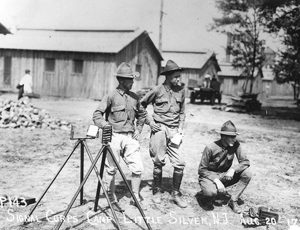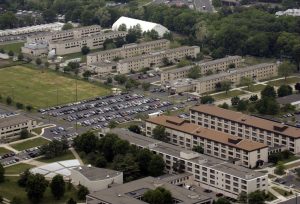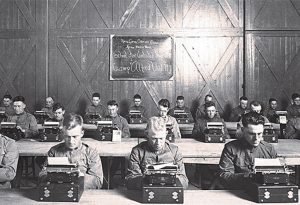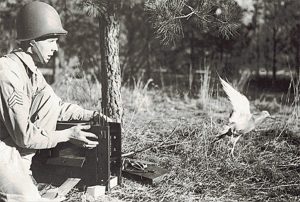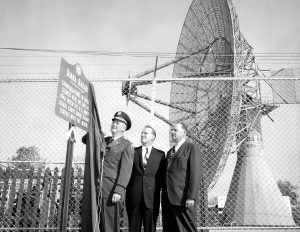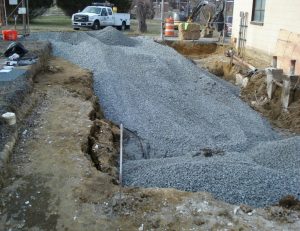FORT MONMOUTH SITE HISTORY
Beginnings
The main post of Fort Monmouth was established in June 1917 and was originally called Camp Little Silver. In September 1917, after just 3 months, the camp achieved semi-permanent status and was renamed Camp Alfred Vail in honor of the U.S. Army’s then chief Signal Officer. The camp’s original mission was to train Signal Corps operators for World War I. In the first 19 months of the camp’s existence, 129 semi-permanent structures were built, a tent camp established on the site of a former swamp, and a parade ground established on the site of a former marsh. A radio laboratory and an airfield were constructed in 1918. After World War I, Camp Alfred Vail was designated as the site of the Signal Corps School, the only training area for Signal Corpsmen in the country.
In 1925, Camp Alfred Vail gained status as a permanent post and its name was changed to Fort Monmouth. The primary mission of Fort Monmouth continued to be Signal Corps training and electronics research. In 1929, the first radio-equipped weather balloon was launched from Fort Monmouth, which represented the first major development in the application of electronics to the study of weather and atmospheric conditions. Around this time, the post also housed the Pigeon Breeding and Training Center, which bred and trained birds capable of flying in darkness to exchange communications.
World War II
Much of the communications equipment used by U.S. Armed Forces during World War II was designed and developed at Fort Monmouth during the 1930s. One of the most important technologies developed at Fort Monmouth during this time was radar, which emerged from the defensive need to counter the possibility of massive aerial bombardment. Other active projects by the Signal Corps at this time included the development of a searchlight control and gun laying detector, a surface vessel detector, and a long-range aircraft detector. By June 30, 1941, Fort Monmouth was home to more than 1,200 civilian personnel and 28 military officers.
To support the expanding operations and personnel at Fort Monmouth, additional property was purchased during World War II for three additional ancillary camps: Camp Coles near Red Bank, Camp Evans in Wall Township, and Camp Charles Wood in Tinton Falls. During the war, the post had housing for 1,559 officers and 19,786 enlisted personnel. The main post housed the Signal Corps Officer Candidate School, which was the major activity on the main post during the war. More than 21,000 officers completed the Officer Candidate Course during World War II. After the war, a Separation Center was established at Fort Monmouth in September 1945. The center separated more than 1,000 servicemembers from the U.S. Army every day until January 31, 1946.
RECENT HISTORY AND CLOSURE
After World War II, Fort Monmouth remained a vital part of research and development for technologies used by the U.S. military during the Cold War and Vietnam War. Some of the research activities conducted in Fort Monmouth laboratories include radios, field TV cameras, radiation dosimeters, satellite instrumentation, laser communication, microelectronics, night vision, defibrillator pacemakers, and lithium batteries. From 1981 until its closure in 2011, Fort Monmouth served as the headquarters of the U.S. Army Communications-Electronics Command (CECOM).
The post was designated for closure by the Base Realignment and Closure (BRAC) Commission in 2005. At that time, CECOM was ordered to relocate to Aberdeen Proving Ground in Maryland. Fort Monmouth officially closed on September 15, 2011, affecting some 4,653 civilian jobs and 620 military personnel.
As part of the BRAC process, the U.S. Army is required to identify and document the environmental liabilities associated with the disposal of property at the Fort Monmouth site. The records provided on this website represent actions and research completed in relation to this process at the Fort Monmouth site.
BRAC ENVIRONMENTAL CLEANUP STATUS
Fort Monmouth is a relatively clean post because its primary mission was research and development. The U.S. Army has identified sites on the property with contamination from expected sources such as petroleum, volatile chemicals, underground and above-ground storage tanks, toxic chemicals, and hazardous wastes. After extensive analysis, the U.S. Army determined that the risk to health and the environment from these items is minimal and can be addressed with land use controls. The U.S. Army continues to work closely with the Fort Monmouth Economic Revitalization Authority (FMERA) and the New Jersey Department of Environmental Protection (NJDEP) to resolve the remaining environmental issues. Given the age of the installation, both lead-based paint and asbestos are present, quantified, and are being dealt with in accordance with regulatory requirements. There appear to be no environmental impediments to the transfer of land associated with Fort Monmouth. As of October 2019, 1,012 of 1,126 acres (90%) of Fort Monmouth land has been transferred via agreements with FMERA. There were originally 22 environmental sites associated with Fort Monmouth (Main Post and Camp Charles Wood). Of those, 5 sites have reached the status of “Response Complete,” and 17 sites remain open as of October 2019. Of the 17 open sites, 9 are former landfill areas that will reach “Response Complete” status in 2023.
Additional information regarding the progress of environmental cleanup and land conveyances can be found in the records contained on this website as well as the U.S. Army BRAC Division’s October 2020 Conveyance Progress Report.
ADDITIONAL PHOTOS AND RESOURCES
Additional information about the history of Fort Monmouth can be found in the two resources below. To download these resources, click on the respective links.
- A Concise History of Fort Monmouth, New Jersey and the U.S. Army CECOM Life Cycle Management Command. CECOM LCMC Historical Office, 2009. Click here to download.
- A History of Army Communications and Electronics at Fort Monmouth, New Jersey, 1917-2007. Office of the Deputy Chief of Staff for Operations and Plans, U.S. Army CECOM Life Cycle Management Command, 2008. Click here to download.
